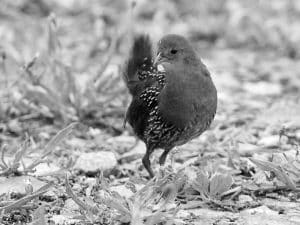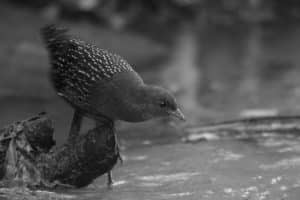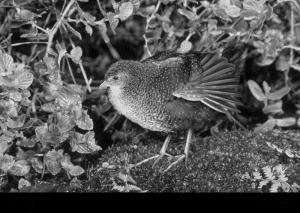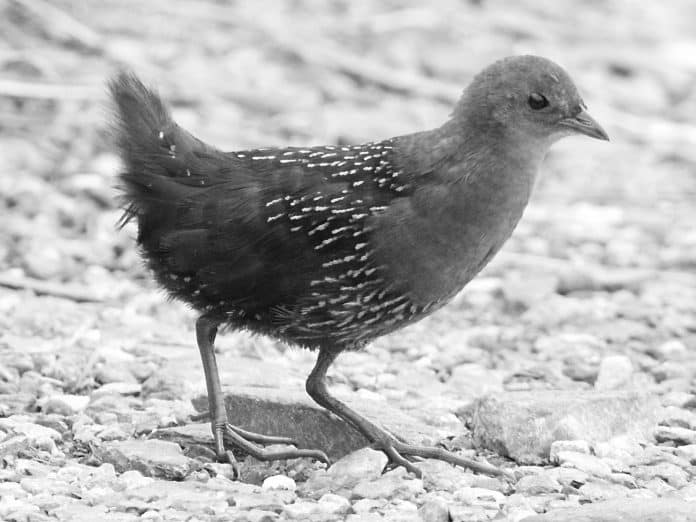Introduction to the Red-Chested Flufftail
The Red-Chested Flufftail, known scientifically as Sarothrura rufa, is a small bird species that can be found in the beautiful marshlands of Tanzania. It is a true gem among the avian inhabitants of this region, captivating birdwatchers with its vibrant rufous plumage and unique behaviors. The Red-Chested Flufftail in Tanzania is a member of the rail family, which is characterized by their secretive nature and preference for dense vegetation. In this article, we will delve into the fascinating world of the Red-Chested Flufftail and explore its habitat, physical characteristics, conservation status, and more.
Habitat and Distribution of the Red-Chested Flufftail in Tanzania

The marshlands of Tanzania provide an ideal habitat for the Red-Chested Flufftail. These lush wetlands, characterized by tall grasses, reeds, and waterlogged areas, offer the perfect environment for the bird to thrive. The Red-Chested Flufftail can be found in various regions across Tanzania, including the wetlands of Serengeti National Park, Lake Manyara, and the Kilombero Valley. These areas are rich in biodiversity, attracting a wide range of bird species and making them prime locations for birdwatching enthusiasts.
Physical Characteristics and Behaviors of the Red-Chested Flufftail
The Red-Chested Flufftail is a small bird, measuring approximately 14-16 centimeters in length. It is characterized by its rufous-colored plumage, which covers its chest and upper body. The bird’s head and back are adorned with dark brown feathers, while its belly is a pale buff color. The Red-Chested Flufftail also possesses a short tail, which it often flicks and bobs while foraging for food or communicating with other members of its species.
Despite its vibrant appearance, the Red-Chested Flufftail is a notoriously elusive bird. It prefers to remain hidden among the dense vegetation of the marshlands, using its cryptic plumage to blend seamlessly with its surroundings. This secretive behavior makes spotting the Red-Chested Flufftail a thrilling challenge for birdwatchers. However, if lucky, you may catch a glimpse of this magnificent bird as it darts through the undergrowth or emerges briefly into open water.
Conservation Status and Threats to the Red-Chested Flufftail
The Red-Chested Flufftail is classified as a vulnerable species by the International Union for Conservation of Nature (IUCN). Its population has been declining due to habitat loss and degradation caused by agricultural expansion, drainage of wetlands, and climate change. The destruction of its natural habitat poses a significant threat to the Red-Chested Flufftail’s survival. Additionally, the bird’s secretive nature makes it difficult to monitor and study, further complicating conservation efforts.
To protect the Red-Chested Flufftail and its habitat, it is crucial to raise awareness about the importance of wetland conservation. Efforts must be made to promote sustainable land use practices, restore degraded wetlands, and establish protected areas for the bird’s preservation. By supporting local conservation organizations and ecotourism initiatives, we can contribute to the long-term survival of this rufous gem amidst Tanzanian marshlands.
Birdwatching Opportunities in Tanzanian Marshlands
Tanzanian marshlands offer unparalleled opportunities for birdwatching enthusiasts. With its diverse range of habitats, the country is home to a remarkable array of bird species, including the elusive Red-Chested Flufftail. The wetlands of Serengeti National Park, Lake Manyara, and the Kilombero Valley are particularly renowned for their avian biodiversity.
To make the most of your birdwatching experience, it is advisable to visit these marshlands during the early morning or late afternoon when bird activity is at its peak. You can explore the wetlands by foot or opt for a guided boat tour to access the more inaccessible areas. Remember to bring a good pair of binoculars, a field guide, and a camera to capture the magical moments you encounter.
Tips for Spotting the Red-Chested Flufftail in its Natural Habitat

Spotting the Red-Chested Flufftail requires patience, skill, and a keen eye. Here are some tips to increase your chances of encountering this elusive bird in its natural habitat:
- Listen for its call: The Red-Chested Flufftail has a distinct call, consisting of a series of short and rapid notes. Familiarize yourself with its unique vocalization, as this will greatly assist in locating the bird.
- Stay silent and still: The Red-Chested Flufftail is easily startled, so it is essential to minimize noise and movement. Find a concealed spot near the marshland’s edge and observe quietly, allowing the bird to become accustomed to your presence.
- Observe the undergrowth: The Red-Chested Flufftail prefers to forage and seek cover within the dense vegetation of the marshlands. Scan the undergrowth carefully, paying attention to any movement or rustling of leaves that may indicate its presence.
By following these tips and maintaining a respectful distance, you increase the likelihood of spotting the Red-Chested Flufftail and enjoying an unforgettable birdwatching experience.
Other Bird Species Found in Tanzanian Marshlands
In addition to the Red-Chested Flufftail, Tanzanian marshlands are teeming with a multitude of bird species. From majestic herons and egrets to colorful kingfishers and weavers, the wetlands offer a spectacular showcase of avian diversity. Some notable species you may encounter include the African Fish Eagle, Malachite Kingfisher, Grey Crowned Crane, and the Purple Gallinule.
The marshlands also serve as a crucial habitat for migratory birds, such as the European Bee-eater and the White Stork, which travel great distances to breed and feed in these wetland ecosystems. Exploring the Tanzanian marshlands provides a unique opportunity to witness the marvels of bird migration and appreciate the interconnectedness of global bird populations.
Ecotourism and the Importance of Protecting the Red-Chested Flufftail’s Habitat
Ecotourism plays a vital role in the conservation of the Red-Chested Flufftail and its habitat. By engaging in responsible tourism practices, visitors can contribute to the protection of the bird and its marshland ecosystem. Choosing eco-friendly accommodations, supporting local conservation organizations, and respecting wildlife and their habitats are some of the ways tourists can make a positive impact.
Furthermore, ecotourism initiatives provide valuable economic incentives for local communities to conserve the marshlands. By promoting the sustainable use of natural resources and providing alternative livelihood opportunities, these initiatives help alleviate poverty while safeguarding the Red-Chested Flufftail’s habitat for future generations.
Conservation Efforts and Organizations Working to Protect the Red-Chested Flufftail
Several conservation organizations are actively working to protect the Red-Chested Flufftail and its habitat in Tanzania. One such organization is the Tanzanian Bird Atlas Project, which aims to document and monitor bird populations across the country. Their research provides crucial data for conservation planning and supports the implementation of effective protection measures.
The Wildlife Conservation Society of Tanzania is another prominent organization dedicated to the preservation of Tanzania’s biodiversity. They collaborate with local communities, government agencies, and international partners to conserve the country’s wetlands and raise awareness about the importance of protecting species like the Red-Chested Flufftail.
By supporting these organizations through donations or volunteering, individuals can contribute directly to the conservation efforts aimed at safeguarding the Red-Chested Flufftail and its marshland home.
Conclusion

The Red-Chested Flufftail is a rufous gem amidst the Tanzanian marshlands, captivating birdwatchers with its vibrant plumage and elusive nature. As a vulnerable species, it faces numerous threats due to habitat loss and degradation. However, through responsible tourism, conservation efforts, and support for local organizations, we can ensure the long-term survival of this magnificent bird.
Visiting the marshlands of Tanzania offers a unique opportunity to witness the beauty of the Red-Chested Flufftail and explore the rich avian biodiversity of the region. By immersing ourselves in nature and appreciating the interconnectedness of all living beings, we can cultivate a deeper understanding and respect for the delicate ecosystems that sustain us all.

































